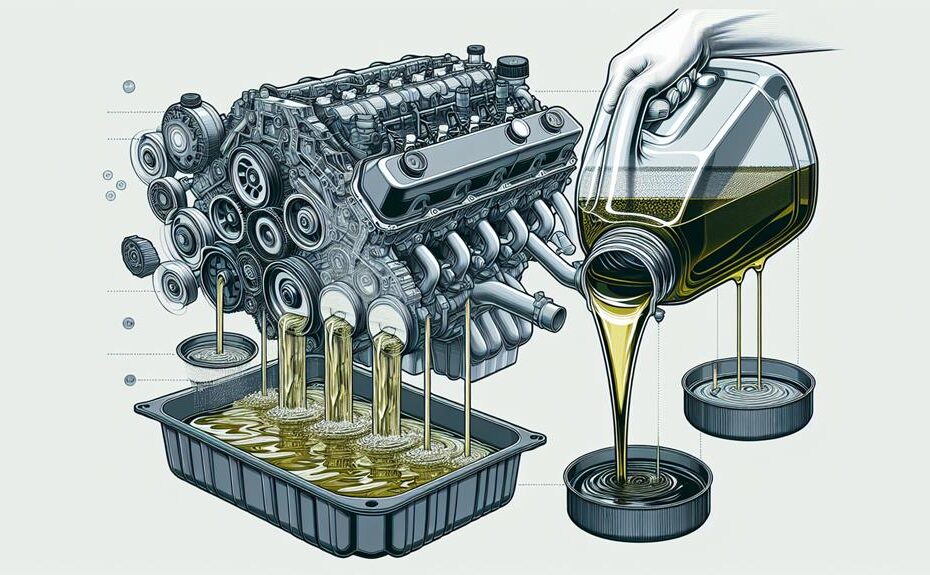Have you ever wondered how often you should change the oil in your car?
It's a common question among car owners, and the answer can vary depending on several factors.
In this discussion, we will explore the recommended frequency for oil changes, taking into account manufacturer's recommendations, mileage-based guidelines, time-based considerations, the difference between synthetic and conventional oil, and the signs that indicate an oil change is needed.
By the end of this discussion, you will have a clear understanding of when and why you should change your car's oil, ensuring optimal performance and longevity.
Key Takeaways
- Manufacturers provide specific guidelines for oil change frequency based on factors such as engine type, driving conditions, and oil quality.
- Mileage-based guidelines suggest oil changes every 5,000 to 7,500 miles for normal driving conditions, 3,000 to 5,000 miles for severe driving conditions, and 2,000 to 3,000 miles for heavy towing/off-road.
- Time-based considerations are important in addition to mileage, with recommended oil changes at least once a year to prevent oil deterioration due to temperature fluctuations and moisture buildup.
- Synthetic oil offers advantages such as better viscosity performance in extreme temperatures and enhanced engine protection, but may have compatibility issues with older engines and higher cost compared to conventional oil. Conventional oil is lower in cost and suitable for older engines, but requires more frequent oil changes and has reduced performance in extreme temperatures.
Manufacturer's Recommendations
Manufacturers typically provide specific guidelines for the recommended frequency of oil changes to ensure optimal performance and longevity of your vehicle. Following the manufacturer's guidelines is crucial in maintaining your vehicle's engine health and preventing potential damage.
The manufacturer's guidelines for oil changes are based on extensive research and testing specific to each vehicle model. These guidelines take into account factors such as the type of engine, driving conditions, and the quality of oil used. By following these guidelines, you can be confident that you're providing your vehicle with the proper care it needs.
Extended oil change intervals have become more common due to advancements in engine technology and the quality of synthetic oils. However, it's important to note that not all vehicles are designed for extended intervals. It's crucial to consult your vehicle's owner's manual or contact your manufacturer to determine the appropriate interval for your specific model.
While extended oil change intervals may save you time and money in the short term, it's essential to consider the potential long-term consequences. Neglecting regular oil changes can lead to engine sludge buildup, reduced fuel efficiency, and increased risk of engine damage. It's always better to err on the side of caution and follow the manufacturer's guidelines to ensure the optimal health and performance of your vehicle's engine.
Mileage-Based Guidelines
When considering mileage-based guidelines for oil changes, it is important to take into account the specific needs of your vehicle's engine and driving conditions. Adhering to proper oil change intervals is crucial for maintaining optimal fuel efficiency and engine longevity. The recommended frequency for oil changes varies depending on factors such as the type of engine oil used, the age and condition of the vehicle, and the driving habits of the owner.
To provide a clearer understanding, refer to the table below which outlines some general mileage-based guidelines for oil changes:
| Driving Conditions | Recommended Oil Change Interval |
|---|---|
| Normal | Every 5,000 to 7,500 miles |
| Severe | Every 3,000 to 5,000 miles |
| Heavy Towing/Off-road | Every 2,000 to 3,000 miles |
| Synthetic Oil | Every 7,500 to 10,000 miles |
Time-Based Considerations
To ensure optimal engine performance and longevity, it's important to consider time-based considerations for oil changes in addition to mileage-based guidelines. While mileage is a commonly used indicator for oil changes, the time interval between oil changes should also be taken into account.
Over time, oil can deteriorate due to factors such as temperature fluctuations, moisture buildup, and chemical breakdown, even if the vehicle hasn't reached the recommended mileage for an oil change. Therefore, it's recommended to change the oil at least once a year, even if the mileage hasn't been reached.
This is especially important for vehicles that are driven infrequently or for shorter distances, as they may experience prolonged periods of engine idle time, which can lead to oil degradation. Engine idle time refers to the time when the engine is running but the vehicle isn't in motion. During this time, the engine isn't operating at its optimal temperature, which can result in the accumulation of contaminants and moisture in the oil.
Synthetic Oil Vs. Conventional Oil
Synthetic oil and conventional oil are two widely used options for lubricating engines, each with its own distinct characteristics and advantages. Understanding the differences between the two can help you make an informed decision about which type of oil is best suited for your engine.
Advantages of Synthetic Oil:
- Better viscosity performance in extreme temperatures, ensuring optimal lubrication even in cold starts or high-temperature conditions.
- Enhanced engine protection due to its superior resistance to oxidation and thermal breakdown, resulting in reduced wear and tear on engine components.
Disadvantages of Synthetic Oil:
- Higher cost compared to conventional oil.
- Potential compatibility issues with older engines, as synthetic oil may cause leaks or seal degradation.
Advantages of Conventional Oil:
- Lower cost compared to synthetic oil.
- Suitable for older engines that may not be compatible with synthetic oil.
Disadvantages of Conventional Oil:
- Reduced performance in extreme temperatures, potentially leading to inadequate lubrication and increased engine wear.
- More frequent oil changes required due to quicker breakdown and oxidation.
Signs of Oil Change Needed
If your engine is exhibiting any of these clear indicators, it may be time for an oil change. One common misconception is that you should change your oil every 3,000 miles. While this was true in the past, advancements in engine and oil technology have extended the recommended interval. Today, most vehicles can go 5,000 to 7,500 miles between oil changes. However, it's important to pay attention to your engine's behavior as it may require an oil change sooner.
One sign that your engine needs an oil change is the appearance of dark, dirty oil on the dipstick. Fresh oil is amber or light brown in color, so if you notice a significant change in color, it's time for a change. Another indicator is the presence of engine noise. If you hear a knocking or ticking sound coming from your engine, it could be a sign that the oil is no longer effectively lubricating the moving parts. Additionally, if you notice a burning smell coming from your engine, it could be a sign of oil that has become contaminated or is no longer providing adequate protection.
If you prefer to do your own oil changes, here are some DIY oil change tips. First, make sure you have the correct oil and filter for your vehicle. Consult your owner's manual or a trusted automotive resource for the right specifications. It's also important to have the necessary tools, such as a wrench, oil filter wrench, and drain pan. Before starting, park your vehicle on a level surface and let the engine cool down. Then, locate the oil drain plug and oil filter. Place the drain pan beneath the drain plug, remove the plug, and let the old oil drain out completely. Once drained, replace the drain plug and remove the old oil filter. Before installing the new filter, lubricate the rubber gasket with fresh oil. Then, install the new filter and tighten it by hand. Finally, refill the engine with the recommended amount and type of oil. Double-check the oil level, start the engine, and check for any leaks.
Frequently Asked Questions
Can I Use Synthetic Oil in My Vehicle Even if the Manufacturer Recommends Conventional Oil?
You can use synthetic oil in your vehicle, even if the manufacturer recommends conventional oil. Synthetic oil has pros and cons for older vehicles. It also provides better engine performance compared to conventional oil.
How Often Should I Check My Oil Level Between Oil Changes?
To properly maintain your vehicle's oil level between changes, it's important to check it regularly. This ensures optimal engine performance and longevity. Keeping up with this routine will also help determine the ideal frequency for oil changes.
Are There Any Specific Signs or Symptoms That Indicate My Vehicle Needs an Oil Change, Other Than the Ones Mentioned in the Article?
If you notice any of these signs – low oil pressure, engine knocking, dirty or dark oil, or a burning smell – it may indicate your vehicle needs an oil change.
Can I Switch Between Synthetic and Conventional Oil During Different Oil Changes?
You can switch between synthetic and conventional oil during different oil changes. There are pros and cons to each type, and the choice can affect engine performance. It's important to make an informed decision.
Is It Necessary to Change the Oil Filter Every Time I Change the Oil?
Changing the oil filter is necessary for optimal engine performance. It prevents contaminants from circulating in the engine and causing damage. To determine if an oil filter needs to be changed, follow the manufacturer's guidelines or consult a professional.
Conclusion
Based on manufacturer's recommendations and mileage-based guidelines, the recommended frequency for oil changes is typically every 3,000 to 5,000 miles or every 3 to 6 months.
However, with the use of synthetic oils, this interval can be extended to 7,500 to 10,000 miles.
It's important to consider both mileage and time-based factors to ensure proper engine maintenance.
Neglecting oil changes can result in engine damage and decreased performance.
Keep your vehicle running smoothly by adhering to these recommended intervals.



